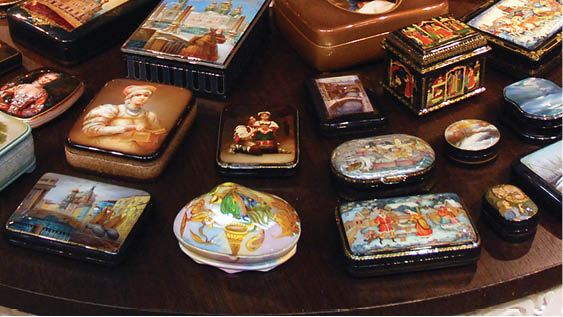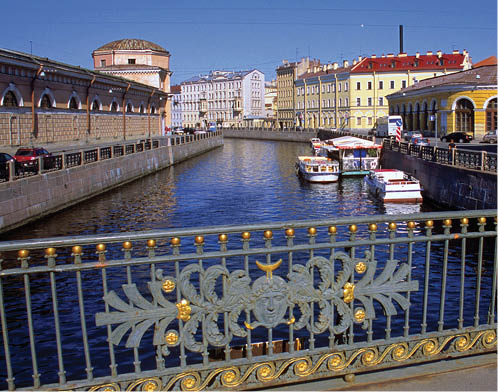Russia


The Hermitage in St. Petersburg.
Russia is a nation forged by conquest but haunted by the fear of collapse. So massive in size it spans 11 time zones and borders 14 other countries, Russia has spent much of its turbulent history defending its frontiers from invasion. The country’s western provinces lie in Europe but its vast eastern hinterland stretches across northern Asia to the Bering Sea where the winters – long, dark and bitterly cold – seem to symbolize the suffering the Russian people have endured over the centuries. None have escaped the despair brought by sieges and starvation, purges and poverty. Even the czars lived in fear, their enemies lurking in palace corridors or on the streets of St. Petersburg where worker unrest was brutally put down.
Today St. Petersburg is the premier port on a Baltic cruise. Most ships dock here overnight so their passengers can see as much as possible of this canal-woven city filled with palaces and churches built when St. Petersburg was the czarist capital of Imperial Russia.

A royal garden at Peterhof.
Russia is the largest country in the world in terms of land area, covering 6.6 million square miles (17 million sq km), but large tracts in the north and east, where the climate is harsh, are sparsely populated. Although Russia enjoys astounding natural wealth, with massive reserves of mineral and energy resources as well as the world’s largest forest reserve, the standard of living of the average Russian remains low due to corruption and the economy’s reliance on raw exports because of its lack of modernization.
Russia’s population is 142 million, with about 12 million living in Moscow, the capital. St. Petersburg’s population is close to 5 million. The average life expectancy for men is 64 years and for women it is 76 years. The major language is Russian and the major religion is Orthodox Christianity although relatively few Russians actively worship – a legacy of seven decades of Soviet rule.
Map of Russia

The Russian Federation is a semi-presidential republic governed by a president and prime minister. Because the president is allowed to serve only two consecutive terms under the Russian constitution, Vladimir Putin stepped aside as president in May 2008 and returned to his former office of prime minister while his hand-picked successor, Dmitry Medvedev, was sworn in as president. Managed elections returned Putin to the presidency in 2012.
Russia remains steeped in superstition, with many believing that the birthmark on Mikhail Gorbachev’s forehead was a sign that he was destined to be a leader of Russia. Russian customs include winter bathing in a steaming hot banya (sauna) followed by a plunge into icy cold water; the temperature contrast is believed to make the body stronger.
Many Russians also believe that the rural way of life reflects the true Russian soul, which is why the tradition of owning a dacha – a rustic retreat in the country – remains the dream of most city dwellers. The building of dachas began in the 18th century when the privileged classes were rewarded with land for their loyalty and service to the czar. During the Soviet era millions of ordinary Russians were granted small plots of rural land where they could build a modest structure and grow vegetables. Today’s dachas feature suburban-style houses and landscaped gardens which appeal to professionals seeking a weekend escape from the city.

A wedding party poses in front of the Winter Palace.
Chess is a popular pastime in Russia, played year-round in city parks. Russian grand masters include Anatoly Karpov and Garry Kasparov, the latter becoming the world’s youngest chess champion when he defeated Karpov in 1985, a title he held for two decades before retiring in 2005 to concentrate on Russian politics. Kasparov was jailed for five days in November 2007 for leading an anti-Putin demonstration in Moscow.
Russian holidays are determined by the Orthodox calendar. Christmas, which was officially forbidden during the Soviet era, is celebrated on January 7, with Christmas mass held on the eve of January 6. New Year’s Eve is the biggest holiday in Russia, celebrated with feasting and other festivities to ensure a prosperous year ahead. Duck or goose, stuffed carp and jellied meats are often served, along with small pies or pastries (pelmeni) filled with cabbage, apple or meat.
For more history of Russia, turn to the History section in Part I.

Finely crafted Russian souvenirs.
The country’s monetary unit is the rouble (1 rouble = 100 kopecks). Shops and restaurants are not allowed to accept foreign currency but US dollars are widely accepted by street vendors (bring bills of various denominations and don’t expect change). Outdoor souvenir markets are located beside the Church on Spilled Blood and in St. Isaac’s Square. Shops are located at the Hermitage, offering high-quality souvenirs and artwork, where payment can be made in roubles or by credit card. Items to look for in St. Petersburg include lacquer boxes, porcelain tableware, hand-painted bowls, matryoshka nesting dolls and Fabergé fine jewellery.

A St. Petersburg canal.
At its height as the capital of czarist Russia, the city of St. Petersburg glittered with imperial splendour. Lavish dinner parties and opulent balls were hosted by the Russian nobility, their horse-drawn carriages whisking counts and countesses along the canal-lined city streets to call at the private palaces of aristocratic friends or to attend a performance of opera or ballet at the Mariinsky Theatre.

‘Peter the Great’ greets tourists in St. Petersburg.
Immortalized in the novels of Tolstoy and Dostoyevsky, St. Petersburg was all that Peter the Great had envisaged in 1703 when he chose the city’s building site at the mouth of the Neva River on land conquered from Sweden. Seeking a Baltic seaport, Peter spared no expense – both in money and human lives – constructing his new capital that would be a ‘window looking on Europe.’ The river delta’s flood-prone marshes made construction difficult, but canals were dug, bridges were built and noble families, under order of the czar, commissioned private palaces along the city’s waterways. Thousands of workers and craftsmen were brought to St. Petersburg to work on Peter’s grand project, and thousands of them died.
Peter, who had travelled throughout Europe, was an admirer of western culture and had hired Italian and French architects to design a city of spacious, classical beauty. He also built the fortress of Peter and Paul on one of the river delta’s many islands to protect St. Petersburg from Swedish naval attacks. In 1712, Peter moved the Russian capital from Moscow to St. Petersburg, which reached its height as an international centre of literature, music, theatre and ballet in the late 19th century. The rich and reckless lifestyles of the Russian nobility, so masterfully described in the novels of Count Leo Tolstoy, were in stark contrast to the fate of the vast underclass of workers who toiled in the city’s factories.
In 1914, when war broke out with Germany, the city was renamed Petrograd (the Slavic version of St. Petersburg), but the name change could not mask the simmering discontent of the city’s soldiers, sailors and factory workers who spearheaded the Russian Revolution of 1917 that toppled Czar Nicholas and his German-born czarina. Replaced the next year by Moscow as the Russian capital, Petrograd was renamed Leningrad in 1924. The city came under terrible siege by German armies during World War II and hundreds of thousands died from famine and disease. A 1991 referendum restored the city’s name to St. Petersburg, a choice favoured by younger Russians.

Constantine Palace was near the front line in the battle for Leningrad in WWII.
Vladimir Putin grew up in St. Petersburg where he lived in a two-room unit of a communal apartment block with his mother (a factory worker) and father (a conscript in the Soviet Navy). As President of Russia, Putin hosted his country’s first Group of Eight summit at the opulent Constantine Palace overlooking the Gulf of Finland on the outskirts of St. Petersburg. Begun by Peter the Great, it had been long abandoned when Putin decided to reconstruct the crumbling palace to commemorate St. Petersburg’s 300th anniversary in 2003. The city founded by Peter the Great is reclaiming its past glory and is once again a window to the West.
